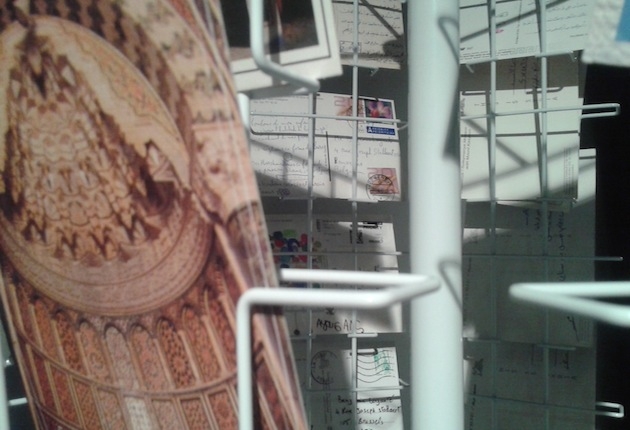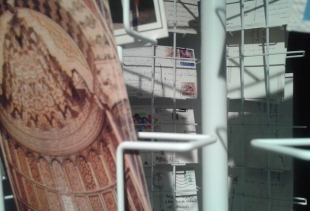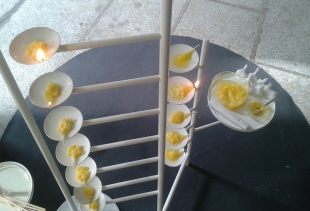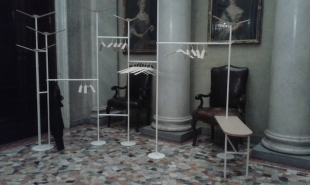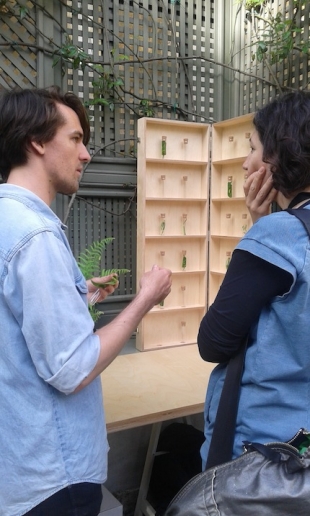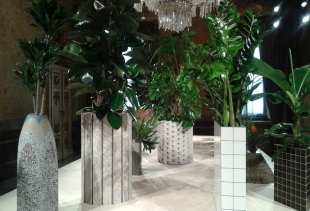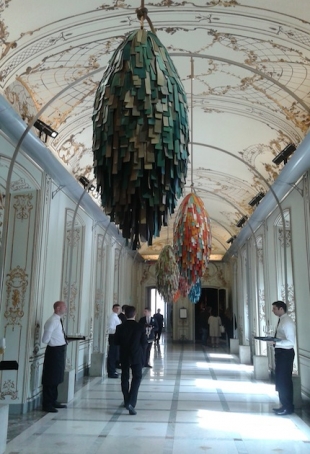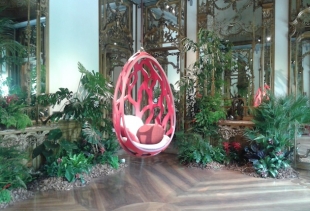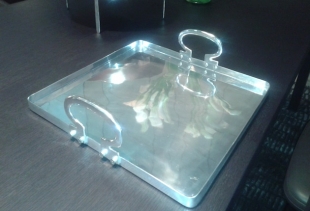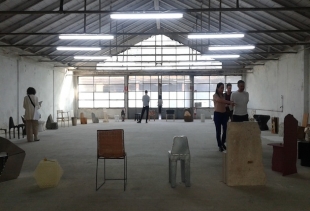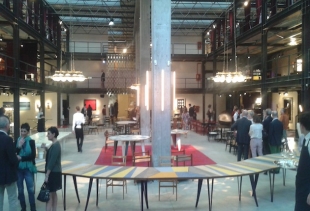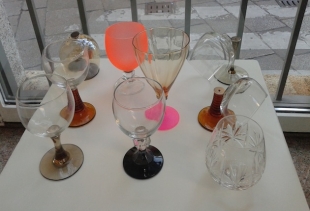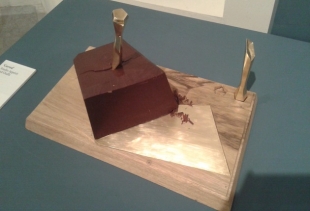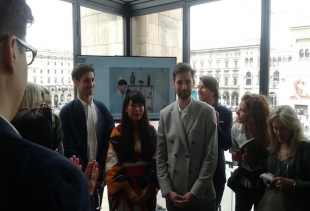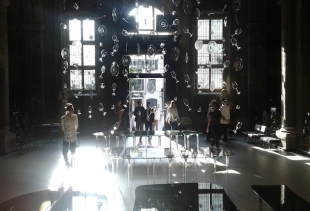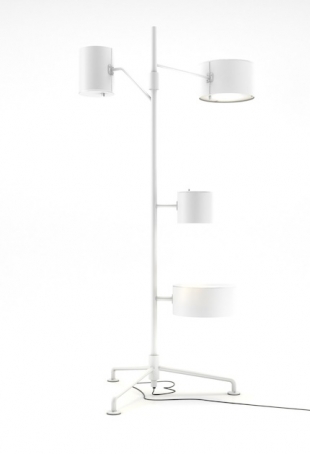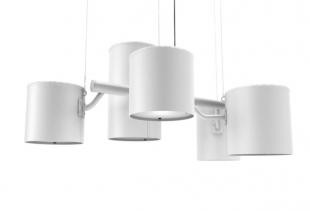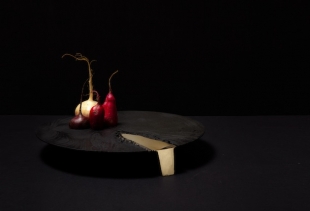» archive blog
-
Carnal, issue 0 of Parterre de Rois
A new magazine in Milandate: 18-07-2013
-
Interview with Nicola Toffolini
A worlds inventordate: 24-04-2011
-
Donne senza uomini.
Installazione multimediale di Shirin Neshatdate: 01-03-2011
The design seen in Milan at the design week between experience and social. It's not more sold out
I fear Milano Design Week 2015 has lost appeal: you can find hotel rooms from a day to another in the city centre and there is no call or physical wait for taxi and/or for public transports (do you remember only few years ago how has been terrible to commute for the fair in Rhò? Now to take a seat in the peak hours on the red subway is not impossible). It is partly for the crisis that reduces the presence of buyers in Milan but also, maybe, for the repetitions in several booths and for the weakness of a lot of proposals. Out from the main fair, the vague “salami sandwich and binge drinking” is the most popular design week event especially in some districts (Tortona and Lambrate uber alles). Taxi drivers told us: in the past years our companies were liberalising the service hours and we were used to switch the engines off when we’re too tired to go on but there was still lots of work to do. Today we dwell a lot to try to fill a normal service hour!
Regarding what was notable this year in the main fair and in the city showrooms, the most innovative exhibits were speaking about experience and lifestyle (more on the side of concepting rather than on products and accessories) and about semantics of objects and of functions. In the more industrial sense, the trends of timeless and made to measure are still strong and aggressive either for more consolidated brands and for small entrepreneurial and niche ones (also coming from the other side of Atlantic).
It is curious but the sole player not belonging to the design industry (but it had shaken up the accommodation and the travelling industry, we speak of the Californian online community and blessed start up Airbnb) targeted the passepartout words of the moment of the furniture industry: experience, sharing, belonging to any place (so to no one). Of course, Airbnb partnered with a design communication agency and research centre to do so, the Italian Fabrica.
It is in the volatility of a touch and of a pause that we totalize a contact – that can be also durable – with cultures, styles, objects. Airbnb fortune has been built on this and design in this case only translate it - and is the mean to translate facts and objects.
Airbnb and Fabrica exhibit took place in and on one of the best properties of Milan, Palazzo Crespi (with the conspiracy of Vannozza Guicciardini, the excellent host we will go to interview for Slow Words). There you were not dealing with a show (and you’re not in the possibility to access as you were heading for any design showroom in town). There you were asked to take an appointment (as it was a concert, you were called to register on a special website to get in, of course for free) or as you’re in the mood to read a book, or to enter a coffee shop where to meet sparkling minds, and so, above all, where you’re certain to cut brilliant atmospheres.
Further (and beyond) to interior design, 19 designers translated the sense to belong to another culture when sharing it with a guest of a different country.
Welcomed by Directions to Somewhere (a very curious either table and portable game: a Coralie Gourquechon’s map created thanks to a Q&A time with the guests/visitors available to play), the journey among lifestyles was then going on with candles pretending to be room-dividers made of butter and cotton by the Indian designer Nikita Bathe, with coat hangers succeeding to become structures re-shaping spaces (this project is the most gifted I saw at the design week this time, signed by Pascal Hein). And also going on with incredible pieces suspended between artistic gestures and design aptitudes, like an app that enables to navigate the mansion searching for fictional experiences. And like mirrors built after cardboard trays for pastries (the Venetian designer Giorgia Zanellato: last year she was signing a clever textile collection called Acqua Alta, this time she was real-time wallpapering the trays with a precious hand-made paper and the audience appreciated: two ladies where buying two trays-mirrors the first day of the show).
Housewarming, this is the title of the exhibition-meteor signed by Airbnb and Fabrica, was also provided by a catalogue that I suggest you to search for: each page is stitched with the following and you need to cut them to read also the contents inside (or if you were able to have the fortune play-cards designed by Catarina Carreiras for the show you can use any of them as a cutter). What any of the stitched pages has hidden in is a listing of a property on Airbnb of the same area of the designer selected to exhibit: ça va sans dire they come from anywhere!
Airbnb drives fast toward luxury and toward social application but the same seems to happen also in other companies or design studio we saw emerging from the flat and blurred mass of others without flavours or direction.
The design Studio Appetit and their talented ideas on table sets for lunches where compliance is not the watchword.
Lexus, beside its traditional design award dedicated to the most talented among the young but already famous signatures in furniture design, prevails over with a kind of ad personam restaurant, a labyrinth where to experience three different states of mind and of nature (better if alone) with the taste, the sense of smell and the entire body. One of these experiences plunges the visitor in the rain (in every direction possible, starting from the tongue, for which a special lollipop has been designed: made in grains able to dissolve on the skin by sparkling as to reproduce in the mouth the sensation of the rain drops insistently beating on the warm tarmac during a summer tempest). Designed by Philippe Nigro, the restaurant (A Journey of the Senses) is an idea by an awarded Japanese food designer, Hajime Yoneda, who has been an IT designer before and does not regret about his former profession.
The sole to suggest a correct semantic experience and relation with object is a Belgian designer, critic and curator, named Benjamin Loyautè (we’ll also interview him on the next Slow Words Weekly).
At Centre Culturel Francais he presented the exhibit Le Bruit des Bonbons (The astonishing Candy Power): we regret it cannot last more than the Design Week itself. It has been a journey of signs and meanings of the sorrow caused by war and of human resistance of a collectivity (the Syrian) where at the middle there is a candy (created for the exhibit starting from an iconic form for the Middle East population, a small man with big eyes, l’idole aux yeux) flavoured of rose, it morphs itself as language and as care (in facts, it is presented in a remedy package).
Above the design who is centred on experience, there is other design seen in Milan the last week and valuable, as the one centring on re-creation, 100% crafted, of the vintage style. Gabriel Hendifar and Jeremy Anderson (Studio Apparatus) design and sell lamps and chandeliers with the charme of the old times but manufactured today with curious exploration and loans of accessories and themes a bit retrò revisited not only for functional purposes. They are also represented by a new New York gallery that opened a space in Milan: it is called BDDW and is able to tell in few words its philosophy: well-made furniture, “because we do not only sell them, we produce them with care and by controlling everything!”.
The owner, with a very cohesive and nice team, also owns a brewery and other artisanal warehouses in the States, they love a specific taste of the other times and are very convinced to produce in their country each of their furniture and the ones of the designers they work with (we are sure also thanks to Obama’s incentives to revitalize the US manufacture industry and capacities).
Also handmade in US, seen at Euroluce, there is Niche Modern, young glass-lighting company based in New York. They design and make very simple and clean pieces with the most horrific colours as they are true and fantastic. All the lamps have the must to let see the bulb: from the multi awarded Plumen to the incredible vintage cylinders Beacon Bulb.
Other brands as Trussardi step back from the binging Fuorisalone and think, very well, only to Salone del Mobile. The Milanese fashion maison does not compromise anymore and after a collection maybe too much vintage presented last year with Michael Young, this time bets on the total home look signed by Carlo Colombo and dedicated to a more aged and maybe more wealthy customer base. Colombo returns back to the experience of the Milano timeless modernity, the one coming after the austerity of the ’70 and after the infatuation kitsch of the ‘80ies (even if entirely recovered from our Fifties). This style has sober forms enriched by very elegantly coloured artisanal details (all the trays and the table accessories are beautiful).
The best stand in fair has been this year the one of Moroso that also introduces new pieces signed by David Adjaye. Watchword, as usual is 'all made to measure'.
Even if on a completely different scale, an artisanal one (and with a less controlled process if compared to those in the bigger industries) the made to measure by young Berlin designer Anna Badur strikes (seen at Salone Satellite, where this year the proposals are less interesting and the section is less extended): we speak of Sierra, Aera and Onda three different collections of tiles painted with natural processes of water absorption.
At Satellite two names to take note of for the future: the iron furniture/silhouette by Officine Calderai and the Copper Hooks by Atelier Max Lipsey.
We end with another total furniture made to measure case that is the same (without taking other streets) every year, this time it shows a very up-to-date collection: we speak of MOOOI, the Marcel Wanders and Casper Vissers’ company given the pair bought it back entirely from B&B. Among the news the more relevant to us, apart the buy-back, we quote two in particular.
The first: MOOOI created a division for Carpet on preview in the Milan showroom, they are often signed by authors who are not only part of the design world. There is a specific part of this catalogue allowing customers to chose their own carpet, also online: they can select not only the size but also the pattern, the fabric and the colours.
The second: with a spectacular exhibition design (this time with the pictures by Rahi Rezvani), the dynamic furniture house shows a new family of lamps with a strong industrial flavour but in the same time provided with a very warm touch (entrancing and highly combinable). The collection is versatile also because is produced in 25 RAL colours: we speak of the Statistocrat signed by Joep Van Lieshout (also a visual artist), already signing furniture for Moooi.
In this case, we are not dealing only with a floor or ceiling lamps but we are dealing with real “stations” of furniture. They can also be a bathroom furniture, a bedroom one or a workshop one thanks to some small platforms and customizable tubulars. And of course, they are lighting very well.
We end up with a curiosity, a very incisive idea – we should say a memento mori or if you may prefer a provocation – before starting a new trial toward a new Design Week (at this point we should say a pointless trip toward the other 2015 fairs). The curiosity, provocation or memento mori is the one of a small furniture producer based in The Netherlands: he goes counter-current and shows (only) a book (ok, he did it at Rossana Orlandi’s gallery and we just hope he sold well the edition deluxe given the space has a very high rent). We speak of Thomas Eyck: also with the sponsorship of two crucial donors for internationalisation (as the Creative Industries Fund NL and Materiaal Fonds) he publishes a book from a research by Christien Meindertsma who analyses (and portray, with Mathijs Labadie) the ashes of the dumped materials, discovering a treasure in elements and minerals hidden in these discards of consumering society.
We speak of Bottom Ash Observatory, only 79 euro.
In the same place – the luxury suk created by Rossana Orlandi – almost covered in a stand rent by another brand, there is the project of Rossana’s pr (the ex fashion designer was always around there during the design week days, her face half hidden by her gigantic white sunglasses). We speak about Marco Tabasso (her right hand but also left crutch, already working on his own last year with a brand of bulbs): he signs a new project between art and design with her wife (the photographer Tatiana Uzlova) and with the designer Robert Anderiessen. Anotherview is a videowall in form of a window (vintage, of course). A recovered frame encapsulates a projection that can be totally customizable either in days and in views for those are deprived of them. Which ones, interior or exterior landscapes?
The idea seems partially already seen (at Arco and at Art Basel fairs some editions ago: respectively a kind of porthole of a cruise liner in a colder and more deluxe habit; a selection of views by photographer Philiph Lorca di Corcia who worked with polaroid), but is reworked with a clever way.

